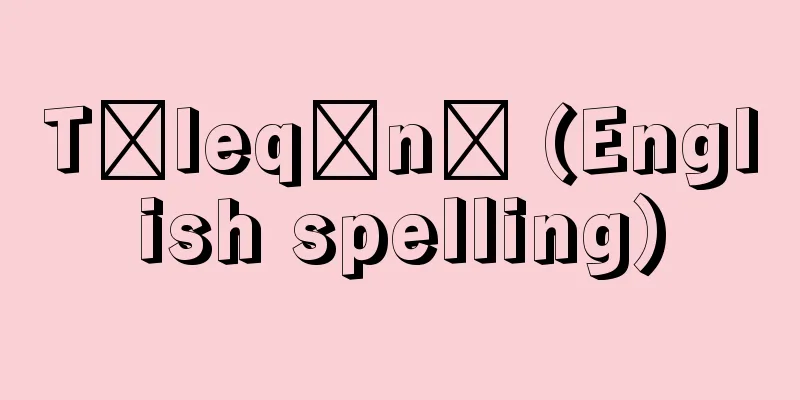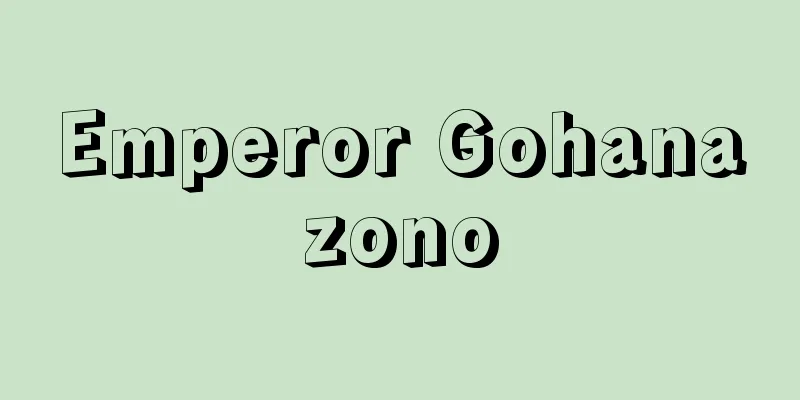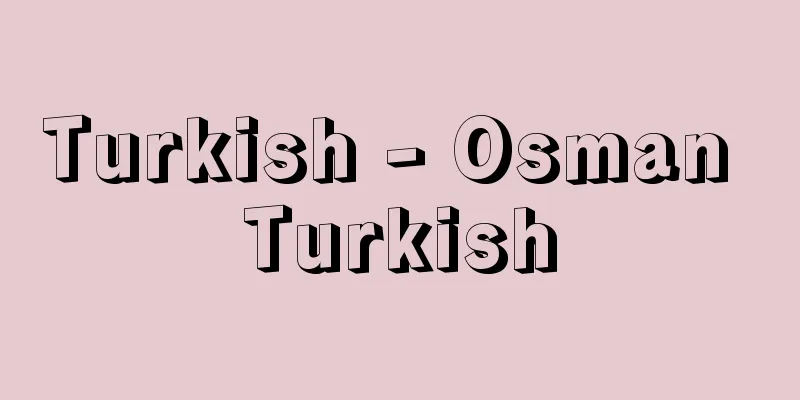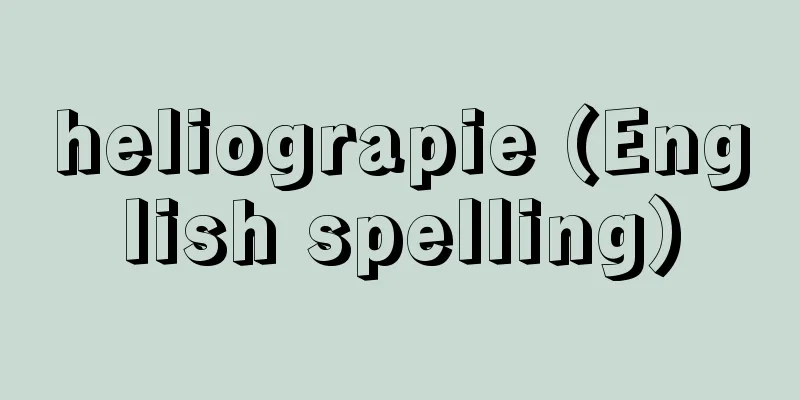Music education - ongakukyoiku
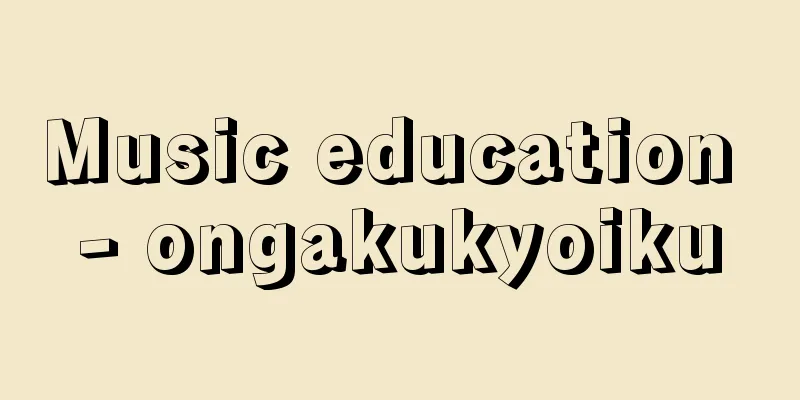
|
Music education is aimed at developing the potential for aesthetic responses inherent in humans by providing a variety of musical experiences, including performance, appreciation, and understanding of music, as well as the creation of musical products. Organized music education is practiced in schools, and is broadly divided into two categories: music education as part of the subject education in general education at elementary, middle, and high schools, and specialized education at universities and junior colleges that trains musicians and music teachers. Of these, music education in general education is particularly important, as it plays a part in human development by cultivating the ability to appreciate aesthetic things and fostering rich emotions. [Hiroshi Kawahara and Yoshinobu Nishizono] Founding periodMusic education in Japan's general education system began in 1880 (Meiji 13) as singing education at the elementary school attached to the Tokyo Normal School for Men and Women. It was implemented by L. W. Mason, a music educator invited from the United States, at the request of Izawa Shuji, a commissioned officer of the Music Investigation Section (Tori Shirabegakari) established in the Ministry of Education the previous year in 1879. Subsequently, from 1881 to 1884, the Music Investigation Section published three volumes of the "Elementary School Song Collection," which were used as singing teaching materials in elementary schools nationwide. This collection of songs was compiled based on the Music Investigation Section's main policy of "creating national music" by blending Eastern and Western music, and featured traditional gagaku-style songs as well as European folk songs and songs such as "Hotaru no Hikari" and "Niwa no Chigusa." The Music Investigation Office also published books on music theory such as "Music Questions and Answers" and "Music Instruction," promoting the development of music education in the early days of the university, which aimed to promote health and cultivate virtue. In 1887 (Meiji 20), the Music Investigation Office was renamed Tokyo Music School (the forerunner of the Faculty of Music at Tokyo University of the Arts) and became Japan's first independent specialized music educational institution directly controlled by the Ministry of Education, primarily teaching knowledge and skills in Western music. [Hiroshi Kawahara September 19, 2018] Late Meiji PeriodWith the establishment of the school education system through the School Act of 1886 (Meiji 19), the development of new school song teaching materials was rushed, and many song collections were published. Among them, "Meiji Songs" (1888) edited by Owada Takeki et al. and "Elementary School Songs" (1893) edited by Izawa Shuji were groundbreaking works. On the other hand, in the run-up to the Sino-Japanese War (1894-1895), many military songs were written to strengthen national sentiment, and were not only sung by the military and civilians, but were also adopted as the main teaching materials for school songs. After that, around 1900 (Meiji 33), the singing teaching materials that had been difficult to understand, with literary lyrics, were reconsidered, and many new works were published from the perspective of colloquial lyrics that were in line with children's lives, and songs with a high level of artistic quality. Representative examples include "Momotaro" and "Kintaro" in "Children's Songs" (1900) edited by Tamura Torazō and others, "Hatopoppo" and "Oshogatsu" in "Kindergarten Songs" (1901) edited by Taki Rentarō and others, and "Kojo no Tsuki" and "Hakoneyama" in "Junior High School Songs" (1901) edited by the Tokyo Music School. In 1907 (Meiji 40), the revision of the Elementary School Act made singing a compulsory subject in elementary schools, with the purpose of cultivating aesthetic sensibility and virtue. In 1910, the nationally-approved "Ordinary Elementary School Reader Songs" was published. Between 1911 and 1914, a total of six volumes of "Ordinary Elementary School Songs" were produced, including "Spring Has Come," "Voices of Insects," and "I Am a Child of the Sea," and these were adopted in elementary schools throughout the country from the Taisho period to the early Showa period. Several books on singing teaching methods were published, and research into teaching materials and methods for singing in elementary schools progressed. However, singing as a compulsory subject in junior high schools was rarely practiced. In terms of specialized education, the first private music school, the Oriental Music School (the precursor to the Tokyo College of Music), was established in 1907, and attracted attention as the first in Japan to organize an orchestra. [Hiroshi Kawahara] Taisho and early Showa periodsFrom the Taisho period to the first half of the Showa period (until 1941, when elementary schools were renamed national schools), new teaching theories and diverse practical theories of music education were developed, such as the development of the children's song movement, research into children's vocal techniques, the advocacy of music appreciation education, and a rapid increase in music education books, all influenced by the liberal education ideas and art education ideas introduced from the West. Of particular note is the children's song movement that began in 1918 (Taisho 7) as a reaction against the rigid content of the nationally designated "Ordinary Elementary School Songs." In the same year, a new children's magazine "Akai Tori" (Red Bird) was launched, led by writer Suzuki Miekichi, poet Kitahara Hakushu, and composer Narita Tamezo, and children's songs rich in Japanese emotion that suited the feelings of children, such as "Kanariya" and "Akai Tori Kotori" (Red Bird and Little Bird), appeared and were widely loved. The latest music education theory (1934) by Yoshio Kusakawa, published during this period, is a noteworthy document that aimed to establish music education theory. In terms of specialized education, Osaka Music School (the precursor to Osaka College of Music) was established in 1915, Tokyo Higher Conservatory (the precursor to Kunitachi College of Music) in 1926, and Musashino Music School (the precursor to Musashino College of Music) in 1929 (Showa 4). During the period from 1941 (Showa 16) to the end of World War II in 1945, when schools were in the National School system, the subject of singing was renamed "Arts and Music" and learning areas such as appreciation and instrumental music were added. However, in order to train young citizens during the war, emphasis was placed on education in pitch, and militaristic music education practices using music as a means were implemented. [Hiroshi Kawahara] After World War IIAfter World War II, the goals and content of music education came to be set out in curriculum guidelines. These are revised roughly every ten years in line with social developments. According to the music section of the elementary and junior high school curriculum guidelines published in 1947 (Showa 22), the goal of music education is to "understand and appreciate the beauty of music, and thereby cultivate high aesthetic sensibility and rich humanity." This goal was based on criticism of the music education philosophy up until the end of World War II, which treated music education as a means to other ends, and explicitly stated that music education should be arts education, with the value of music itself as its goal. The areas of study consisted of singing, instrumental music, appreciation, and composition. Before the war, music education was centered on singing, but this time all areas of musical activity were included in the study, and students began to study Western music systematically. In the elementary and junior high school curriculum guidelines revised in 1951, the goal of music education was stated as "to cultivate deep aesthetic sensibility and rich humanity through musical experience, to promote the development of a well-rounded personality, and to enhance the culture required for a respectable member of society," emphasizing the connection between music and social life. Then, composition became "creative expression," and "rhythmic response" was added, making the five areas of study "singing, instrumental music, appreciation, creative expression, and rhythmic response." In 1958 (Showa 33), new curriculum guidelines for elementary and junior high schools were published. The goal for elementary schools was to "enrich musical experience, develop musical sensibility, and cultivate aesthetic sensibility," concisely explaining the relationship between music education and character development. Areas of activity were organized into expression (singing, instrumental music, and composition) and appreciation. In this revision, with the aim of having favorite songs that transcend generations, several songs for singing and appreciation were designated as "common teaching materials" for each grade in both elementary and junior high schools, and were to be taught in common in all schools nationwide. The three songs for elementary school singing were selected mainly from Ministry of Education songs, such as "Haru no Ogawa" (Stream in Spring) and "Furusato" (Hometown). Although the content has changed slightly, the goals, learning areas, and common teaching materials of school music education have basically continued since then. The word "emotions" has remained consistent among the goals of music education since the end of World War II. In Japan, school music education is positioned as a subject that is responsible for the education of "emotions" in terms of human education. On the other hand, music education in society is carried out in various forms and plans, such as music schools run by musical instrument companies, private music academies, and music schools aimed at talent education. All of these aim to enrich children's lives through music by having them experience the joy of music and acquire skills on specific instruments through individual or group activities. In terms of specialized education, music teachers are trained at national teacher training colleges and music departments in each region, while performers and composers are trained at national, public and private art and music universities.In addition, national, public and private art and music universities, including national teacher training colleges and faculties of education, have established graduate schools where music education and music research is conducted. [Nishizono Yoshinobu] Music Education in the 21st CenturyThe challenges for music education in Japan in the 21st century include, first, teaching traditional Japanese music through children's songs and Japanese instruments, and second, contributing to the development of academic ability in line with the characteristics of the music subject. In the 1998 revision of the curriculum guidelines, it was stipulated that "at least one type of Japanese musical instrument should be used throughout the three years" as part of the content of instrumental music instruction in junior high schools, marking the first time that Japanese schools would provide instruction in Japanese musical instruments as performance experience. This prompted a revision of the Educational Personnel Certification Act in 2000, making it mandatory to take courses in "Japanese musical instruments" and "traditional Japanese singing" to obtain a license to teach "music" at junior high or high schools. Furthermore, the 2006 revision of the Fundamental Law of Education stipulated that the educational goal should be to cultivate an attitude of respect for Japanese traditions and culture, which led to further enhancement of instruction in traditional Japanese music in schools. Since the Meiji era, music education in Japanese schools has been taught using materials based on Western musical styles. However, the 21st century is an era of further progress in globalization, and people are interacting on an international level. In this context, it is important to establish a Japanese identity by understanding the characteristics and merits of one's own country's traditions and culture, and to foster an attitude of respect for the cultures of other countries as well as the traditions of Japan. To achieve this, it is necessary to systematically teach traditional Japanese music in school music education through children's songs, folk songs, and Japanese instruments such as the shamisen, koto, shakuhachi, and taiko drums. On the other hand, the development of children's academic ability has become a social issue due to international comparisons of academic ability. The 2007 revision of the School Education Act specified the content of academic ability to be developed at school, including motivation to learn, knowledge, and skills, as well as thinking, judgment, and expression. It is also necessary to develop academic ability in music according to the characteristics of the subject. Therefore, the 2008 revision of the music curriculum guidelines for elementary and junior high schools added new "common items" as teaching content that is commonly required to develop the ability to express and appreciate. The content is to perceive the elements that make up music and to feel the characteristics and atmosphere that these functions create. Perceiving elements means identifying the elements that make up music, such as tone, rhythm, and melody, and the relationships between them. Sensing characteristics and atmosphere means, for example, perceiving the characteristics of the tone of a violin, such as transparency, spaciousness, and velvety luster, as well as the uplifting and profound atmosphere that is created by the relationship between the elements. Cultivating the ability to perceive these musical elements and to sense their characteristics and atmosphere will help develop our emotional thinking skills and will foster academic ability that is in line with the characteristics of the subject. To achieve this, it is important to develop music classes that make use of "common grounds." [Nishizono Yoshinobu] "A Study of the Establishment of Singing Education, by Yamazumi Masami (1967, University of Tokyo Press)" ▽ "Music Education Theory, by Kuda Taketsugu (1975, Ongaku No Tomosha)" ▽ "The History of Music Education in the Postwar Showa Period, by Kimura Nobuyuki (1993, Ongaku No Tomosha)" ▽ "A Study of Educational Practice Concerning the Construction of Elementary School Music Curriculum - Aiming to Cultivate the Ability to 'Know Art'" by Nishizono Yoshinobu (2005, Kazama Shobo)" [References] | | | | | |Ueno Park, Shita-ya Ward (present-day Ueno Park, Taito Ward, Tokyo). "Illustrated Guide to Famous Places in Tokyo" (1912, Meiji 45), National Diet Library . Tokyo Music School Source: Shogakukan Encyclopedia Nipponica About Encyclopedia Nipponica Information | Legend |
|
音楽の演奏および鑑賞と理解、さらに音楽的所産をもたらす創作などを含む多様な音楽体験を与えることによって、人間が所有している美的反応に対する潜在能力の発達を目的として行われる教育である。組織的な音楽教育は学校において実践され、それは、小学校や中・高等学校の普通教育における教科教育の一環としての音楽教育と、大学や短期大学における音楽家や音楽教師を養成する専門教育との二つに大別される。そのなかで、とくに、美的なものを評価する感性の能力を培い、豊かな情操を養うことによって、人間形成の一翼を担う普通教育での音楽教育が重要である。 [川原 浩・西園芳信] 創立期日本の普通教育における音楽教育は、1880年(明治13)に東京男女両師範学校附属小学校における唱歌教育として発足した。それは、前年1879年に文部省内に創設された音楽取調掛(とりしらべがかり)の御用掛伊沢修二の意図のもとに、アメリカから招いた音楽教育家L・W・メーソンによって実施された。続く1881年から1884年にかけて『小学唱歌集』全3編が音楽取調掛によって刊行され、全国の小学校における唱歌教材として用いられた。この唱歌集は、東西の音楽を折衷して国楽を制定する「国楽の創成」という音楽取調掛の大方針に基づいて編集され、伝統的な雅楽風の歌曲、および『蛍の光』『庭の千草』などヨーロッパ民謡や歌曲が取り上げられていた。また音楽取調掛は『音楽問答』や『音楽指南』などの音楽理論書を出版し、健康の増進と徳性を養うことを目的とした創立期の音楽教育の発展を促進した。 1887年(明治20)に音楽取調掛は東京音楽学校(東京芸術大学音楽学部の前身)と改称され、文部省直轄の日本最初の音楽の専門教育機関として独立し、主として西洋音楽の知識、技能を教育した。 [川原 浩 2018年9月19日] 明治後期1886年(明治19)の学校令による学校教育制度の整備に伴って、新しい学校唱歌教材の開発が急がれ、多くの唱歌集が出版された。なかでも、大和田建樹(たけき)他編『明治唱歌』(1888)、伊沢修二編『小学唱歌』(1893)などは画期的な著作であった。一方では日清(にっしん)戦争(1894~1895)に向かって、国民感情を強化するために多くの軍歌がつくられ、軍隊や民間で歌われたのみならず、学校唱歌の主たる教材としても採用された。その後1900年(明治33)ごろから、それまでの理解しにくい文語歌詞の唱歌教材が見直され、子供の生活に即した口語歌詞による言文一致唱歌、また芸術性の高い歌曲というような観点から、多くの新しい作品が公表された。田村虎蔵(とらぞう)他編『幼年唱歌』(1900)の『桃太郎』『金太郎』、滝廉太郎(たきれんたろう)他編『幼稚園唱歌』(1901)の『鳩(はと)ぽっぽ』『お正月』、また東京音楽学校編『中学唱歌』(1901)の『荒城の月』『箱根山』などがその代表的なものである。 1907年(明治40)の小学校令の改正で、小学校における唱歌が必修教科となり、美感と徳性を養うことがその目的とされた。1910年には国定の『尋常小学読本唱歌』が刊行された。続く1911年から1914年にかけて、『春が来た』『虫のこえ』『われは海の子』などが含まれる『尋常小学唱歌』全6巻がつくられ、大正年間から昭和初期にわたり全国の小学校で採用された。唱歌教授法に関する著作もいくつか出され、小学校唱歌教材、教授法の研究が進められた。しかし中学校における必修教科としての唱歌はほとんど実践されなかった。専門教育の面では、1907年に最初の私立音楽学校の東洋音楽学校(東京音楽大学の前身)が設立され、日本で初めて管弦楽を組織して注目された。 [川原 浩] 大正、昭和初期大正期から昭和前半期(昭和16年まで。この年、小学校は国民学校と改称)までの時代は、欧米から導入された自由主義教育思想や芸術教育思想の影響を受けて、童謡運動の展開、児童発声法の研究、音楽鑑賞教育の提唱、音楽教育書の激増など、音楽教育の新しい教授理論や多様な実践論が展開された。特筆すべきことは、国定の『尋常小学唱歌』の堅苦しい内容に対する反動として、1918年(大正7)に童謡運動がおこったことである。作家鈴木三重吉(みえきち)、詩人北原白秋(はくしゅう)、作曲家成田為三(ためぞう)らが中心となり、同年、新児童雑誌『赤い鳥』が創刊され、『かなりや』『赤い鳥小鳥』などの子供の心情に添い日本的情緒豊かな童謡が登場し広く愛唱された。この期に刊行された草川宜雄著『最新音楽教育学』(1934)は、音楽教育学の確立を目ざした注目すべき文献である。専門教育の面においては、1915年、大阪音楽学校(大阪音楽大学の前身)、1926年、東京高等音楽院(国立(くにたち)音楽大学の前身)、1929年(昭和4)、武蔵野(むさしの)音楽学校(武蔵野音楽大学の前身)がそれぞれ設立された。 1941年(昭和16)から、第二次世界大戦が終結する1945年までの国民学校時代は、唱歌科が「芸能科音楽」と改められ、学習領域として鑑賞や器楽などが加えられた。しかし、戦時期の少国民を練成するために音感教育を重視するなど、音楽を手段とした軍国主義的な音楽教育実践が行われていた。 [川原 浩] 第二次世界大戦後第二次世界大戦後は、音楽教育の目標や内容などについては、学習指導要領によって示されるようになった。これは、社会の進展とともにほぼ10年ごとに改訂されている。1947年(昭和22)に刊行された小・中学校学習指導要領音楽編によると、音楽教育の目標は、「音楽美の理解・感得を行い、これによって高い美的情操と豊かな人間性を養う」となっている。この目標は、音楽教育をほかの目的の手段とする、第二次世界大戦前までの音楽教育思想への批判に基づくもので、音楽そのものの価値を目的とした芸術教育としての音楽教育が明示された。 学習領域は、歌唱・器楽・鑑賞・創作からなる。戦前は歌唱中心であった音楽教育を音楽活動のすべての領域を学習の対象とし、それにより西洋音楽を体系的に学ぶようになった。続いて、1951年(昭和26)に改訂された小・中学校学習指導要領では、音楽教育の目標を「音楽経験を通じて、深い美的情操と豊かな人間性とを養い、円満な人格の発達をはかり、好ましい社会人としての教養を高める」とし、音楽と社会生活とのつながりが強調されている。そして、学習領域は、創作が「創造的表現」となり、新たに「リズム反応」が加わり、歌唱・器楽・鑑賞・創造的表現・リズム反応の5領域となった。 1958年(昭和33)には、小・中学校の新しい学習指導要領が刊行された。小学校における目標は「音楽経験を豊かにし、音楽的感覚の発達を図るとともに、美的情操を養う」となり、音楽教育と人間形成との関連が簡潔に示されている。活動領域は、表現(歌唱・器楽・創作)、鑑賞と整理された。そして、このときの改訂では、世代を超えて愛好曲をもつとする趣旨から、小・中学校とも学年ごとに歌唱曲と鑑賞曲の数曲を「共通教材」として指定し、全国すべての学校で共通に学習する教材とした。小学校の歌唱曲の3曲は、『春の小川』『ふるさと』など文部省唱歌を中心に選曲されている。 このような学校の音楽教育の目標と学習領域、共通教材の指定については、内容が少し変化するものの基本的にはそれ以降に継続されている。第二次世界大戦後の音楽教育の目標のなかで、一貫して変わることなく見られる言葉は「情操」である。日本においては、学校の音楽教育は人間教育としては「情操」の教育を担う教科として位置づけられている。 一方、社会における音楽教育は、楽器企業によって経営されている音楽教室や個人的な音楽塾、あるいは才能教育をねらいとした音楽教室など、さまざまな形態や計画に基づいて展開されている。いずれも個別または集団による活動を通して、音楽の楽しさを経験させるとともに特定の楽器の技能を身につけさせることで、音楽によって子供たちの生活を充実させることをねらいとしている。 専門教育としては、各地域の国立の教員養成大学や教育学部の音楽科においては、音楽教師が、そして、国・公・私立の芸術大学や音楽大学においては、演奏家や作曲家などが養成されている。また、国立の教員養成大学や教育学部を含め国・公・私立の芸術大学や音楽大学においては、大学院研究科が設置され、音楽教育研究や音楽研究がなされている。 [西園芳信] 21世紀の音楽教育21世紀の日本の音楽教育の課題としては、一つは、わらべうたや和楽器などによって日本の伝統音楽を指導すること、もう一つは、音楽の教科の特性に即して学力の育成に寄与することがあげられる。 1998年(平成10)の学習指導要領の改訂では、中学校の器楽の指導内容として「和楽器については、3年間を通じて1種類以上の楽器を用いること」とし、日本の学校の音楽教育において、和楽器を演奏経験として指導することが初めて示された。そして、これを契機に2000年には教育職員免許法も改定され、中学校や高等学校の「音楽」の免許を取得するには、「和楽器」や「日本の伝統的な歌唱」の履修が必須となった。さらに、2006年の教育基本法の改正で教育の目標に日本の伝統と文化を尊重する態度を養うことが規定されたことから、学校で日本の伝統音楽の指導をいっそう充実させることとなった。 明治以降の日本の学校での音楽教育は、西洋音楽の様式にのっとった教材によって指導してきた。しかし、21世紀の世界は、グローバリゼーションがいっそう進展し、人々が国際的な立場で交流する時代である。そういったなかでは、自国の伝統と文化の特徴とよさを理解することによって日本人としてのアイデンティティを確立すること、そして、日本の文化などの伝統を尊重するとともに、諸外国の文化をも尊重する態度を育成することが重要となる。そのためには、学校の音楽教育においても、わらべうたや民謡、三味線・箏(そう)・尺八・太鼓などの和楽器によって、日本の伝統音楽を体系的に指導することが課題となる。 一方では、学力の国際比較等から、子供の学力育成のことが社会的問題となっている。2007年(平成19)の学校教育法の改正では、学ぶ意欲や知識・技能を含め、思考力・判断力・表現力等、学校で育成する学力の内容が示された。音楽も教科の特性に即して学力を育成することが必要となる。そこで2008年の小・中学校学習指導要領音楽の改訂では、表現と鑑賞の能力を育成するうえで共通に必要となる指導内容として新たに「共通事項」を設けている。その内容は、音楽を形づくっている要素を知覚し、それらの働きが生み出す特質や雰囲気を感受することである。要素の知覚とは、音色・リズム・旋律などの音楽を形づくっている要素やそれらの関連を識別することで、特質や雰囲気の感受とは、たとえばバイオリンの音色でも透明感、広がり、ビロードのような光沢といった特質や、また、要素の関連の働きで生み出される高揚する感じ、重厚な感じといった雰囲気を質として感じ取ることである。この音楽の要素を知覚し、特質や雰囲気を感受する学力を育成することが、われわれの感性的思考力を育むことになり、教科の特性に即した学力の育成となる。そのためには、「共通事項」を生かした音楽授業の開発が課題となる。 [西園芳信] 『山住正己著『唱歌教育成立過程の研究』(1967・東京大学出版会)』▽『供田武嘉津著『音楽教育学』(1975・音楽之友社)』▽『木村信之著『昭和戦後音楽教育史』(1993・音楽之友社)』▽『西園芳信著『小学校音楽科カリキュラム構成に関する教育実践学的研究――「芸術の知」の能力の育成を目的として』(2005・風間書房)』 [参照項目] | | | | | |下谷区上野公園(現在の東京都台東区上野公園)。『東京府名勝図絵』(1912年〈明治45〉)国立国会図書館所蔵"> 東京音楽学校 出典 小学館 日本大百科全書(ニッポニカ)日本大百科全書(ニッポニカ)について 情報 | 凡例 |
<<: Music competition - Ongakukonkuru (English spelling) music competition
>>: Music school - Ongakugakko (English spelling) conservatory English
Recommend
Gerhardt (English spelling) Charles Frédéric Gerhardt
1816‐56 French organic chemist born in Strasbourg....
Jagiellonczyk, K.
…The Royal Council, which also appeared in the mi...
Sardine drift net fishing
...This type of fishing is the most advanced of a...
Bianjaku - Henjaku
Dates of birth and death unknown. A renowned phys...
Transportation management - Unpankanri
Transportation refers to moving the location of g...
yakow
...A male domestic yak is crossed with a female c...
Geneva International Music Competition (English: Concours International d'Exécution Musicale, Genève)
This is a music competition held every year from ...
Acre - E-kaa (English spelling) acre
A unit of land area in the imperial system. It is...
Tsukubai - Tsukubai
This refers to a style of temizu (water basin) th...
Ibbi-Sin (English spelling)
...Later, his son (or brother) Ur-Nammu gained in...
Cross-current fan - Oryu fan
...It is small and lightweight, and is used for s...
Akhnaton - Akhnaton
...religious reformer. Also known as Akhenaten or...
Asuhamichi - Asuhamichi
…It has long been known as a strategic point on t...
Aminta
…In this environment, Tasso wrote Treatise on Poe...
Asian water buffalo
…the English name for the animals of the Bovidae ...

